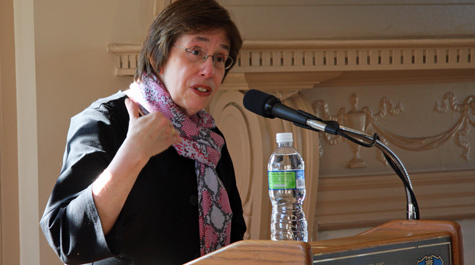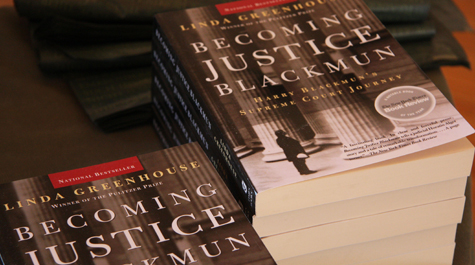Hunter Andrews Fellow discusses changing role of Supreme Court
Greenhouse, who covered the Supreme Court for 30 years and is regarded as one of the most accomplished Supreme Court journalists in the United States, spoke heavily on the constantly changing role of the court in its relationship with the legislative and executive branches of government.
She first talked of an increased interest by the public in the Supreme Court as a whole. Greenhouse used the example of the recent case of Citizen United v. FEC involving a television advertisement that sparked criticism from not only legislators and President Barack Obama, but also stimulated public opinion across the country.
"What's interesting about it is that the public became quickly engaged by this, which is quite unusual," Greenhouse said. "Most Supreme Court decisions drop like stone in the public space."
In addition, she mentioned about how the environment surrounding the court itself was changing as it adopted a more activist stance during this case, a clear deviance from the quiet, retrospective nature it had taken on in the past.
Greenhouse also mentioned the recent confirmation hearings of Supreme Court Justice Sonia Sotomayor as another example of how the public has become more enthralled with the court.
"The question is what do people want to see in the new justice?" she said. "Every Supreme Court nomination comes in a particular similar context. Different issues create different kinds of expectations, certain desires, certain fears."
Even though Sotomayor was eventually confirmed by the Senate, the extreme politics and the media coverage of her selection process showed that people in general cared about the nomination.
"Every time a new justice comes on the court, it's a new court because it's a small group dynamic with just nine people who work together, eat together, and it really matters who your colleagues are in that situation," she said.
Greenhouse said that as full of politics and useless debates the confirmation hearing was filled with, it was still something that could be learned from.
"This is always a sequence of events that, frustrating as they can be and as un-illuminating as they can be, and they were pretty un-illuminating last summer, nevertheless frames a certain public discourse about the Supreme Court," she said.
The confirmation hearings also brought forth the second aspect of the Supreme Court that Greenhouse found to be interesting: the constant shift of power and discourse between the three branches of the government.
To explain the inner-branch power struggle, Greenhouse chose the sequence of cases arising out of the Guantanamo Bay as an example. Due to the fact that President George W. Bush in conjunction with Congress had passed legislation prohibiting the courts from hearing any legal case having to do with the terror suspects in Guantanamo, the courts had no jurisdiction to try any of the terror suspects.
"The focus was a separation of powers issue on the dialogue that's been conducted and slowly been conducted from the very start of this process going back to the immediate aftermath of 9/11 between the three branches of government," she said.
Specifically, she cited a recent case which involved a number of Chinese detainees of the Uyghur population who had been detained in Guantanamo Bay following the 9/11 terror attacks on the United States. Because of jurisdictional issues, the courts could not give the Uygurs the protection of habeas corpus, or in other words, the jurisdictional notification by a court that one is being illegally detained.
"The Uygurs wanted to leave. They got released from Guantanamo, and there was no way the courts could hear the case," she said.
In terms of judicial processes, Greenhouse said that over the years, the courts had become much more efficient and livelier. After the court of Chief Justice Warren Burger, she said that the Supreme Court had found ways to shorten lengthy discussions and opinions so that the court could spread their time over a much wider radius.
Also, she noted the evolution of Supreme Court justices' arguments and how they have grown in importance over time.
"It's all sort of cut and dry, they don't have a lot of personal interaction and that's one reason why after the Burger years, the arguments got livelier," Greenhouse said. "The only way to get your opinion out there and test the responses of your colleagues up and down the bench is to use arguments."
The Hunter B. Andrews Fellowship was established in 1998 in the honor of the former state senator and William & Mary alumnus. The program invites noted figures to the College every year to speak. Greenhouse currently serves as a lecturer at the Yale Law School, a non-lawyer honorary member of the American Law Institute, and serves as a fellow on the American Academy of Arts and Sciences.
 Skip to main content
Skip to main content


